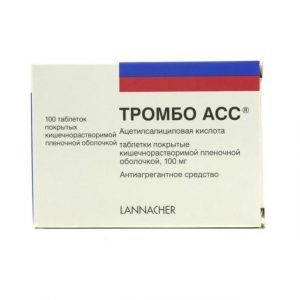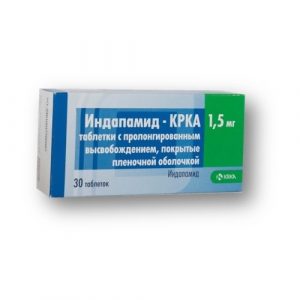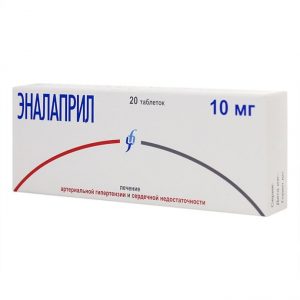Description
Description
Biconvex tablets coated with a white film coating. Cross section shows the inner layer of a white or creamy-white color.
Indications
Arterial hypertension.
Contraindications
Hypersensitivity to indapamide, other sulfonamide derivatives or other components of the
drug Acute cerebrovascular accident
Severe renal impairment (creatinine clearance less than 30 ml / min) and / or also with Simultaneous administration of drugs that prolong the QT interval
Pregnancy
Lactation period
Age up to 18 years (efficacy and safety have not been established)
The shell of the tablet contains lactose, so the drug doesn t Patients with rare hereditary diseases such as galactose intolerance, lactase deficiency or glucose-galactose malabsorption should not take it.
Caution if:
Diabetes mellitus in the stage of decompensation
Hyperuricemia (especially accompanied by gout and urinary nephrolithiasis)
Hyponatremia and other disorders of water-electrolyte metabolism
Moderate hepatic and / or renal failure
Heart disease of heart disease patients with an extended QT interval on an ECG or receiving combination therapy with other antiarrhythmic drugs.
Directions for use
Inside, preferably in the morning, regardless of food intake, 2.5 mg (1 tablet) per day, with plenty of fluids.
If the desired therapeutic effect is not achieved after 4-8 weeks of treatment, increasing the dose is not recommended (the risk of side effects increases without increasing the antihypertensive effect). Instead, it is recommended that another antihypertensive drug that is not a diuretic be included in the drug regimen. In cases where treatment must be started with two drugs, the dose of Indapamide remains equal to 2.5 mg in the morning once a day.
Special instructions
With prolonged use or when taking Indapamide in large doses, electrolyte disturbances such as hyponatremia, hypokalemia, hypochloremic alkalosis can develop. These disorders are more often observed in patients with chronic heart failure (II-IV functional class, NYHA classification), liver diseases, with vomiting and diarrhea, as well as in individuals on a salt-free diet.
The simultaneous use of indapamide with cardiac glycosides and corticosteroids increases the risk of hypokalemia. In addition, the excretion of magnesium by the kidneys may increase, which can lead to hypomagnesemia.
Orthostatic hypotension may occur, which can be triggered by the use of alcohol, barbiturates, narcotic drugs and the simultaneous use of other antihypertensive drugs.
In patients taking cardiac glycosides, laxatives, against the background of hyperaldosteronism, as well as in the elderly, careful monitoring of potassium and creatinine levels is indicated.
The most careful control is shown in patients with cirrhosis, coronary heart disease, chronic heart failure.
The high-risk group also includes patients with an increased QT interval on the electrocardiogram (congenital or developed against the background of any pathological process). The first measurement of the concentration of potassium in the blood should be carried out during the first week of treatment.
Hypercalcemia with Indapamide may be a consequence of previously undiagnosed hyperparathyroidism.
In patients with diabetes, it is extremely important to control the concentration of glucose in the blood, especially in the presence of hypokalemia.
Significant dehydration can lead to the development of acute renal failure (decreased glomerular filtration). Patients need to compensate for fluid loss and carefully monitor renal function at the beginning of treatment.
Indapamide can give a positive result when conducting a doping control.
Patients with arterial hypertension and hyponatremia (due to taking diuretics) need to stop taking diuretics 3 days before taking ACE inhibitors (if necessary, diuretics can be resumed somewhat later), or use initial low doses of ACE inhibitors.
Derivatives of sulfonamide can exacerbate the course of systemic lupus erythematosus (must be borne in mind when using Indapamide).
Composition
One film-coated tablet contains:
Active ingredient:
Indapamide – 2.5 mg
Excipients:
Pregelatinized starch – 41.8 mg
Microcrystalline cellulose – silicon dioxide – 45 mg
5 mg
Magnesium stearate – 0.2 mg
Hypromellose – 1.008 mg
Macrogol – 0.36 mg
Lactose monohydrate – 1.296 mg and titanium dioxide – 0.936 mg
Side effects of
Metabolism: hypokalemia, hyponatremia, hypochloremic alkalosis, hypercalcemia, increased urea nitrogen in blood plasma, hypercreatininemia, glucosuria, hyperuricemia, hyperglycemia.
From the digestive system: dry mouth, vomiting, gastralgia, anorexia, abdominal discomfort, pancreatitis, constipation or diarrhea, hepatic encephalopathy (against the background of liver failure).
From the central nervous system: asthenia, dizziness, nervousness, headache, drowsiness, fatigue, general weakness, insomnia, depression, tension, irritability, anxiety, lethargy, lethargy, agitation, paresthesia, tingling sensation in the limbs.
On the part of the sensory organs: conjunctivitis, visual impairment.
From the respiratory system: rhinitis, cough, pharyngitis, sinusitis.
From the cardiovascular system: orthostatic hypotension, arrhythmia, sensation of palpitations, changes in the electrocardiogram characteristic of hypokalemia.
From the urinary system: nocturia, polyuria, increased incidence of infections.
From the hemopoietic organs: thrombocytopenia, leukopenia, agranulocytosis, bone marrow aplasia, hemolytic anemia.
Allergic reactions: skin rash, itching, urticaria, hemorrhagic vasculitis.
Other: flu-like syndrome, chest pain, malaise, muscle spasm, back pain, decreased libido and potency, rhinorrhea, increased sweating, weight loss, exacerbation of systemic lupus erythematosus, photosensitivity reaction cases have been described.
Drug interaction
With the simultaneous use of indapamide with lithium preparations, an increase in the concentration of lithium in the blood plasma is possible.
Astemizole, erythromycin (iv), pentamidine, sultoprid, vincamine, antiarrhythmic drugs IA (quinidine, disopyramide) and class III (amiodarone, bretilia tosylate, sotalol) can increase the likelihood of heart rhythm disturbances of the torsades de pointes type (ventricular tachycardia type of “pirouette”).
Nonsteroidal anti-inflammatory drugs, glucocorticosteroids, tetracosactide, sympathomimetics reduce the hypotensive effect, baclofen increases.
Saluretics, cardiac glycosides, gluco- and mineralocorticosteroids, tetracosactide, amphotericin B (iv), laxatives increase the risk of hypokalemia.
With simultaneous use with cardiac glycosides, the likelihood of developing digitalis intoxication increases, with calcium preparations – hypercalcemia, with metformin – worsening of lactic acidosis is possible.
Combination with potassium-sparing diuretics may be effective in some categories of patients, however, the possibility of developing hypo-or hyperkalemia, especially in patients with diabetes mellitus and renal failure, is not completely excluded.
Angiotensin-converting enzyme (ACE) inhibitors increase the risk of hypotension and / or acute renal failure (especially with existing renal artery stenosis).
Contrast iodine-containing agents in high doses increase the risk of impaired renal function (dehydration). Before using contrast iodine-containing agents, patients need to restore fluid loss.
Tricyclic antidepressants and antipsychotics increase the hypotensive effect and increase the risk of orthostatic hypotension.
Cyclosporine increases the risk of hypercreatininemia.
Reduces the effect of indirect anticoagulants (coumarin or indandion derivatives) due to an increase in the concentration of coagulation factors as a result of a decrease in the volume of circulating blood and an increase in their production by the liver (dose adjustment may be required).
Enhances neuromuscular transmission blockade that develops under the influence of non-depolarizing muscle relaxants.
Overdose
Symptoms: nausea, vomiting, weakness, impaired gastrointestinal function, water-electrolyte disturbances, decreased blood pressure, dizziness, drowsiness, confusion, respiratory depression, in patients with impaired liver function, hepatic coma may develop.
Treatment: gastric lavage and / or administration of activated charcoal followed by restoration of normal water-electrolyte balance, symptomatic therapy. There is no specific antidote.
Storage conditions
In a dry, dark place, at a temperature not exceeding 25 ° C.
Keep out of the reach of children.
The Expiration of
is 3 years. Do not use after the expiry date stated on the packaging.
Form of Treatment
tablets




